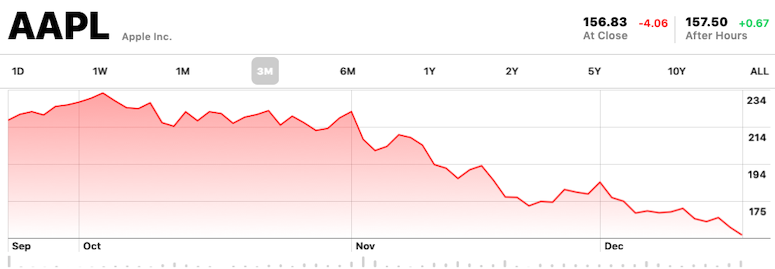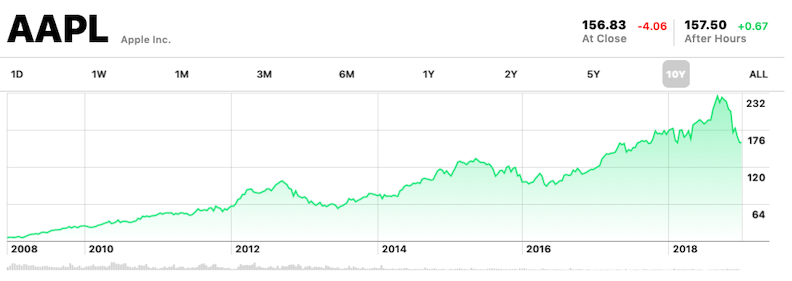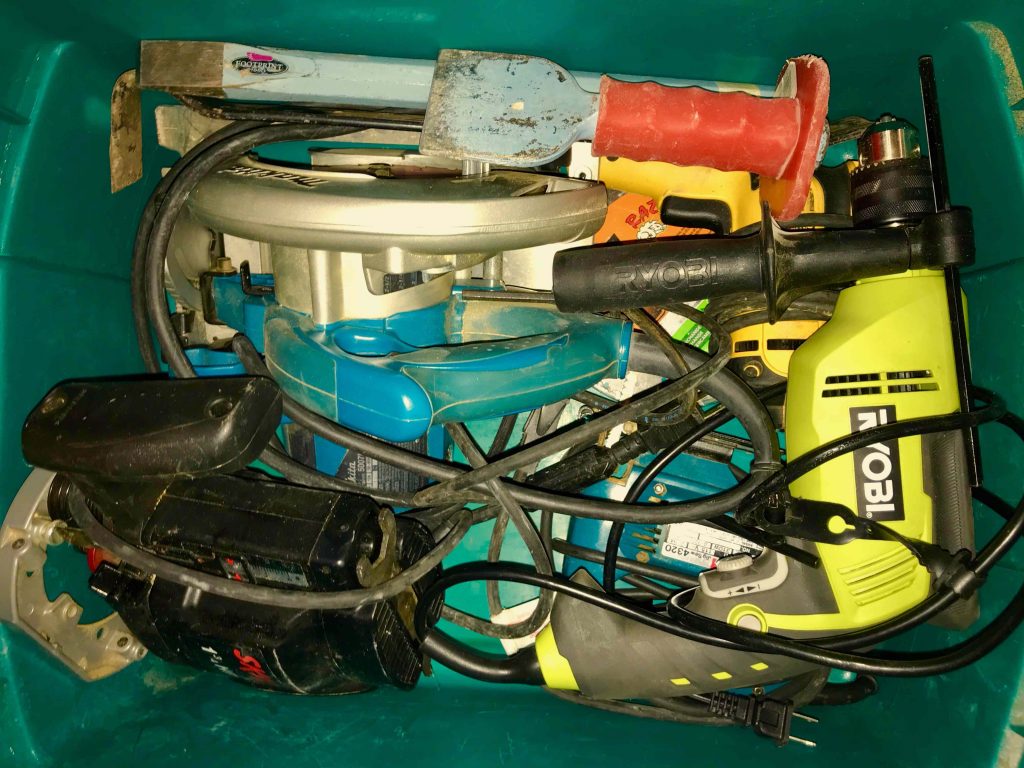The paper statements won’t be arriving for a while, but no one reads those anyway. It’s the online numbers that hurt. It takes some courage to login and look at the big number at the bottom of the page. The one that used to be big. That sickening feeling in your stomach like when you overslept for an exam back in college. Relax. You don’t need to panic about the market. Here’s why:
1. Corrections are normal
Look at the chart for most any stock over a 1 week period. Or even a month. How did it do? Who cares? Always a lottery over the short term. Now look at some long-term data for quality companies. Likely sold growth over 20 or 30 years. Over the long haul, stocks outperform bonds. The short term dips and dives are the price to be paid for the superior returns.
As an example, let’s look at Apple. Here is the company stock chart. A disaster. A price drop from $178 to $156. A heart wrenching plunge of 12.4% in just one month. Even the red shading on the chart looks scary. Good time to sell? Move into something else? There are lots of factors to be considered in making buy and sell decisions, but the short term stock direction, and the shade of the chart isn’t one of them.

Let’s look at the same stock over 10 years. Now the stock goes from $13 to $156. If you invested $10,000 back then, it would be worth $120,000 today. Nice! Even with the recent drop, that is an average annual growth rate of 28.21%. That doesn’t even include the dividends you would have earned. Not a lot of bonds pay that. Pretty good ride. And if you hung in for 10 years, you would have seen plenty of drops, like the 43% one from Sept 2012 to July 2013 where the stock dropped from $98.75 to $56.65. Ouch. But your patience would have been well rewarded.

This doesn’t mean that I am recommending any one stock. Or to buy Apple. Just that corrections are a part of investing. Pull up any stock charting tool and look at short term and long term data for individual stocks and for the market as a whole. The long term trend for quality stocks is up. The short term is, well, we know not what. Build a well diversified portfolio that is suited for your age and risk tolerance and let the power of compounding work for you. Don’t panic about the market.
2. Stocks are on sale
When clothing goes on sale, we rush in to get the best bargains. Boxing Day deals bring out the beast in people. And a 2 for 1 deal can work us into a frenzy. But when stocks go on sale, everyone panics. Why? It’s a chance to buy quality companies for less. Same employees working just as hard to earn you money.
Using the US Dow Jones Index as a view to the overall US market, we see that it has risen from 9,035 to 22,859 over 10 years. Thats an average annual growth rate of 9.73%. Even after the recent drop of 14.5%. By staying in the market and not exiting on the drops (tough to do) an investor would have earned a solid return. And that doesn’t include dividends. Keep investing through the ups and downs with a well diversified portfolio.
3. DRIPs help ease the pain
DRIP stands for dividend reinvestment program. Your financial institution can set this up on your account so that the dividends that you earn are used to buy more of the stocks you already own. The compounding effect is a powerful way to build wealth. In a quality company, the dividends often grow, providing more cash with which to buy more shares. But this becomes even more important as share prices fall since your dividends now buy even more shares since they are on sale. And fewer as prices rise. DRIPs build wealth and help stabilize a portfolio.
4. You don’t need the money right now
For those of us in our 20’s, 30’s, 40’s or 50’s we needn’t be concerned since we likely don’t need our investments right away. The numbers on the statement are just numbers on a statement. They don’t need you reacting to them. Time is the great healer. Keep saving and investing for the long haul. You don’t need to panic about the market.
5. Retiring? You still don’t need to panic about the market
But let’s take the case of a 65 year old who just retired with a plaque, a party, some bad speeches and a gold Apple Watch. Her $500k portfolio has declined 20%. It is now $400k. The projections might suggest that she no longer has enough to live on. Time to panic, or at least sell her Apple Watch? First off, her advisor shouldn’t have had her in a portfolio that could decline 20% at age 65. That is true even if she is her own advisor. But even still, she doesn’t need all of the money this week. The average bear market lasts 11 months. Time for her to withdraw what she needs for now and let the market run its course. When the market recovers there will be an opportunity to rebalance to an investment mix that is better suited to her age.
Summary
Here are a few thoughts to keep in mind as the market tumbles:
- Don’t panic about the market and succumb to the instinct to sell everything. Take the long view. If you own quality companies, they are full of people getting up early and working hard to grow these businesses. If you own their shares, they are your businesses. Stay invested and let them work for you.
- Over time, rebalance your portfolio to get a mix of quality stocks, bonds and cash that is appropriate for your age risk tolerance. A qualified financial advisor or robo advisor can help. Not tips from your Uber driver. Unless she has a Certified Financial Planner. Who loves driving.
- In uncertain times with rising interest rates, the best defence is to aggressively pay down debt and reduce expenditures. Being rich is about spending less than you earn. And the longer you do that, the richer you get. Especially if you invest your savings in quality, well managed companies and give them time to grow. If you need some ideas to reduce your expenses, subscribe to my blog or have a look at Cashflow Cookbook where I offer 60+ “recipes” to reduce recurring expenses. If you are in the Toronto area, I am doing a series of free lectures on wealth building ideas. The complete schedule is here.
- Set up your finances so that a fixed percentage of your income goes directly and automatically into savings. If your employer has a matching RSP or 401k, that is a great place to start. Can’t afford to make the contributions? You can’t afford not too. Reduce other expenditures. Find the money. Make the contributions.
What are your thoughts on the market correction? What are you changing in your approach?
Photo credit Yu Tang of Unsplash




